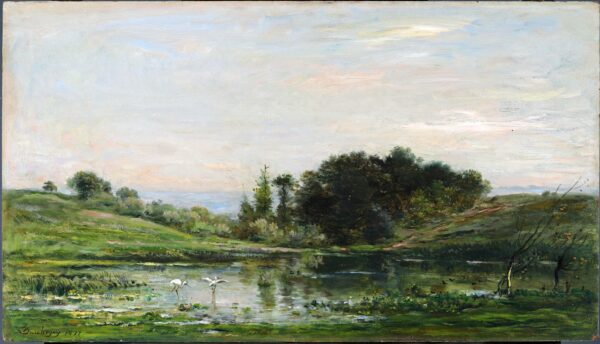“L’Etang de Gylieu”
Oil on panel: 38,5 x 67 cm;
signed and dated(l.l.): ‘Daubigny 1877’
"*" indicates required fields
Notes
Daubigny painted several works of the pond at Gylieu, the first was exhibited in the Salon of 1853. It was his first major success there, which saw the work bought by Napoleon III. Three other later versions are currently in the Cincinnati Art Museum, Philadelphia Musem of Art and the Metropolitan Museum of Art in New York. This particular version was bought by Joseph C. Hoagland in New York after its completion. Joseph was an avid collector of paintings, and his gallery was possibly one of the most notable in Brooklyn at the end of the 19th century. Joseph and his brother Hoagland were descendants of two old Dutch families and the founders of the Royal Baking Powder Company. The Royal Baking Powder Company was one of the largest producers of baking powder in the US and its products are still marketed today.
Background Artist
Charles Daubigny is one of the most important artists of the Barbizon school. He loved nature and was one of the first to advocate ‘plein air’ painting (painting outdoors, instead of in the studio). When painting outside, of course one is confronted with the continuously changing atmosphere and light fall. Daubigny tried to capture this continuous movement by painting ‘impressions of nature’.
Daubigny was born into a family of painters and was taught the art by his father Edmond François Daubigny and his uncle, miniaturist Pierre Daubigny. Initially Daubigny painted in a traditional style, but this changed after 1843 when he settled in Barbizon to work outside in nature. Very important was his meeting with Camille Corot in 1852 in Optevoz (Isère). On his famous boat Botin, which he had turned into a studio, he painted along the Seine and Oise, often in the region around Auvers. From 1852 onward he came under the influence of Gustave Courbet. In 1866 Daubigny visited England, eventually returning because of the Franco-Prussian war in 1870. In London he met Claude Monet, and together they left for the Netherlands. Back in Auvers, he met Paul Cézanne.
His followers and pupils included his son Karl (who sometimes painted so well that his works are occasionally mistaken for those of his father), Achille Oudinot, Hippolyte Camille Delpy, Albert Charpin and Pierre Emmanuel Damoye.
Provenance
- ex-Collection Joseph.C. Hoagland (1841-1899);
- Sotheby’s, New York, 1976, no. 206;
- Gebr. Douwes Fine Art, Amsterdam;
- a private Dutch collection, 1978.
Literature
R. Hellebrandt, ‘Charles-François Daubigny, 1817-1878’, catalogue raisonné, (supplément) 1976, no. 112, p. 41, with ill.

